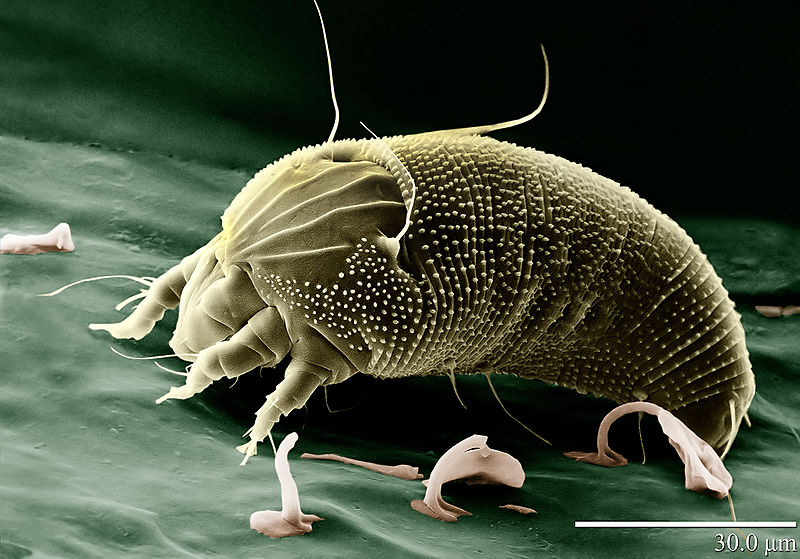As ace reader Janice correctly guessed, the red velvety patches — really galls, or abnormal plant growths caused by the invasion of a parasitic organism — from the last post were created by a tiny erineum mite (Aceria sp.). I’ve seen many a gall in my time, and I *never* suspected that the scarlet patches were the product of gall-making critters. After several years of seeing these scarlet patches and having no bloomin’ idea what they were, I had to consult my old pathology of trees and shrubs professor (and author of “Magical Mushrooms, Mischievious Molds“) Dr. George Hudler, who clued me in.
So what might a mite be, anyway? Well, like the bio-faux pas of calling a mosasaur a dinosaur (Paleontologists: “It’s a marine reptile, d***it!”), never call a mite an insect. It’s a greatly evolved arachnid, like spiders, ticks and most scorpions (excepting the ones with power ballads). Most arachnids have eight legs, plus two pairs of special mouthparts called chelicerae and pedipalps. Mites, which properly include the ticks, are among the most successful invertebrates on earth, and are the only arachnids that have been found in Antarctica. Some are completely self-reliant. But because mites are (as their name accurately implies) so tiny, many others specialize in freeloading, which they have elevated to an art form. They cause mange (sarcoptic mange mites); they live in dust and cause allergies (dust mites); wreak destruction on colonies of honeybees (varroa mites); chew holes in, and cause untold agony among witless, unprepared southerners (chiggers); decimate house plants, including many of the prized specimens of this author (spider mites); and they frolic about your eyelashes, follicles, face, pores and skin, eating dead skin cells and sebum, going out for evening constitutionals on your sleeping face and, I’m sorry to reveal, making more mites (demodex mites).
And they make galls. Though not all plant galls are mite-induced (tiny gall wasps being the other major cause), many are. An entire family of mites, the Eryiophyidae, have adopted this lifestyle, and these galls can take on all sorts of fantastical forms and colors. Erineum mites have a few quirks; they have only two pairs of legs, for example, as you can see above. And they are REALLY tiny. without a dissecting microscope, you are unlikely to be able to see them, even with a hand lens, as they are only .05 to .2 mm long (i.e. 50 – 200 microns long! The spores of the fungus I published my first master’s thesis on where in that range!).
So how do erineum mites coax the plant into making those crazy galls? After overwintering on the tree, the females jump on young leaves and start feeding on the underside. Chemicals in their saliva stimulate the growth of the velvet patch, or erineum (pl. erinea, whence the mites get their name, though whether the scarlet pigment is mite-produced or mite-induced I have not been able to discover). Then they crawl inside. And guess what? The velvet patch is both maternity ward and love shack. That’s right: if this gall’s a rockin’ . . .
The good news for maples (Acer sp., the major target of the aptly named Aceria sp.), is that the galls rarely harm the tree. Instead, think of them as hip, festive forest decor. Without erineum gall, that copse of trees just has no “pop”. : )
To find these suckers in the tree of life, look for Eriophyoidea here, and back out by the arrow on the left to get a sense of where you are.
An additional source used in writing this post can be found here.



{ 3 comments… read them below or add one }
mites aren’t my fave thing ever, but that is a relatively AMAZING looking little dude :)
I had a nightmare about mites last night! Ugh!
so i’ve run across two things in the last day that made me think of you. do you have any info on aflatoxins in peanuts? and what about this guy:
http://cityroom.blogs.nytimes.com/2010/08/06/the-disturbing-mushroom-of-lincoln-place/?scp=2&sq=fungus&st=cse